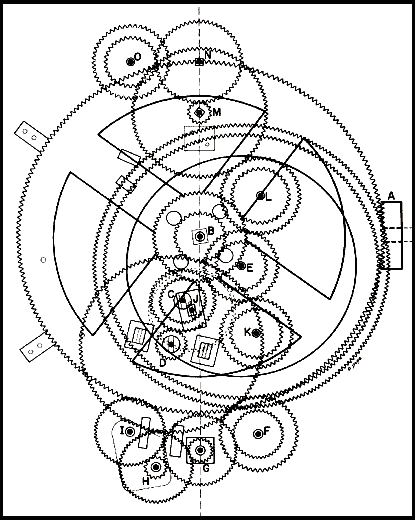The Antikythera Mechanism I
With Java animations by Bill Casselman
The main reference for these columns is printed: the monograph, cited below, by the famous Yale historian of science Derek De Solla Price (other printed references). On the web one can find the complete text of his 1959 Scientific American article on the subject. E. C. Zeeman, K.B., F.R.S. delivered lectures on the topic in 1998 at the University of Texas, San Antonio and at Trinity College, Dublin. The 23 transparencies from these lectures are on the web and it's almost like being there (see his paper for more detail). DivingBum Enterprises has a page with a photograph of the curent installation in the National Museum of Archaeology, Athens. Chris Rorres' page Spheres and Planetaria on the Drexel University site has a nice photograph of Price himself. Rob S. Rice of the University of Pennsylvania has posted a very useful paper on the subject, from a 1995 U.S. Naval Academy symposium on Naval History. A lively sketch of De Solla Price's scientific and human personality can be found in the Foreword, by Robert K. Merton and Eugene Garfield, to one of his books.
Update: Technology available to Tony Freeth and his collaborators, including computed X-ray tomography (like a high-resolution CAT-scan), has allowed a much better understanding of the structure of the mechanism and has shown that earlier work by Price, while correctly assessing the intellectual scale of the Greek's achievement, was dead wrong on many of the details. Read about some of the discoveries made in 2009 here.
1. The history of the Mechanism
The Antikythera Mechanism is the name given to an astronomical calculating device, measuring about 32 by 16 by 10 cm, which was discovered in 1900 in a sunken ship just off the coast of Antikythera, an island between Crete and the Greek mainland. Several kinds of evidence point incontrovertibly to around 80 B.C. for the date of the shipwreck. The device, made of bronze gears fitted in a wooden case, was crushed in the wreck, and parts of the faces were lost, ``the rest then being coated with a hard calcareous deposit at the same time as the metal corroded away to a thin core coated with hard metallic salts preserving much of the former shape of the bronze'' during the almost 2000 years it lay submerged. The quotation is from Derek de Solla Price's monograph Gears from the Greeks ... in the 1974 Transactions of the American Philosophical Society (Volume 64, part 7).

General plan of all gearing, composite diagram
from De Solla Price, Transactions of the American Philosophical
Society Vol 64 No 7 (1974). Reproduced with permission. |
It is hard to exaggerate the singularity of this device, or its importance in forcing a complete re-evaluation of what had been believed about technology in the ancient world. For this box contained some 32 gears, assembled into a mechanism that accurately reproduced the motion of the sun and the moon against the background of fixed stars, with a differential giving their relative position and hence the phases of the moon. It is enough to know that there is no trace of anything like it until around 1000 A.D., and that when it was first published there were serious suggestions that it had been dropped into the wreck at a much later date or even that it was the work of alien astronauts.
The general plan of the gearing could only be drawn after 1971 when, on De Solla Price's instigation, the remnants of the mechanism were viewed with gamma rays, which could penetrate the calcareous block in which the gears were embedded. Then careful counting of teeth, and examination of the way the gears meshed, showed that ``the gear ratios could be associated with well-known astronomical and calendrical parameters'' (Price) and allowed the almost complete description of how the device must have functioned.
This is the first of two columns on the Antikythera Mechanism. In each we will examine one part of the mechanism that has special mathematical interest. This month it is the Sun-Moon assembly, next month: the Differential Gear.
|
--Tony Phillips
SUNY at Stony Brook
Welcome to the
Feature Column!
These web essays are designed for those who have already discovered the joys of mathematics as well as for those who may be uncomfortable with mathematics.
Read more . . .
Feature Column at a glance



